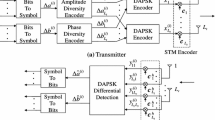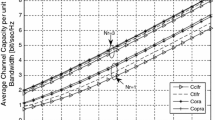Abstract
Average error probability and outage probability for an asynchronous direct sequence spread spectrum multiple access communications through slow nonselective Nakagami fading channels are evaluated for nondiversity and diversity receptions. Using the Gauss quadrature rule, the moments of the self-interference and the multiple access interferences are used to evaluate average error probability and outage probability. Combining the diversity technique and error correcting codes, comparisons between the uncoded nondiversity DS-SSMA system and that of the coded diversity system are shown for the Gold Code of codelength 127. Using fourth-order diversity and the Reed-Solomon code, the maximum achievable number of users is 12 percent of the codelength for Rayleigh fading, when the average probability is 10−3. The corresponding outage probability is less than 5 percent. Performance comparisons between Rician and Nakagami fading channels are made. Since the system is interference limited, the performance seems to show no significant difference for the two fading channel models when the number of users is large.
Similar content being viewed by others
References
A. Salmasi and K.S. Gilhousen, On the system design aspects of code division multiple access (CDMA) applied to digital cellular and personal communications networks, 41st IEEE Vehicular Tech. Conf. (1991)57–62.
K.S. Gilhousen, I.M. Jacobs, R. Padovai, A.J. Viterbi, L.A. Weaver and C.E. Wheatley, On the capacity of a cellular CDMA system, IEEE Trans. Vehicular Tech. VT-40(1991)303–312.
E. Geraniotis, Direct-sequence spread-spectrum multiple-access communiations over nonselective and frequency-selective Rician fading channels, IEEE Trans. Commun. COM-34(1986)756–764.
K.T. Wu, Average error probability for DS-SSMA communications through Nakagami fading channels, in:Proc. Int. Symp. Commun., Tainan, Taiwan, 1991.
M. Kavehrad, Performance of nondiversity receivers for spread spectrum indoor wireless communications, AT&T Tech. J. 64(1985)1181–1210.
W.C.Y. Lee, Overview of cellular CDMA, IEEE Trans. Vehicular Tech. VT-40(1991)291–302.
M. Nakagami, Them-distribution — A general formula of intensity distribution of rapid fading, Reprint from:Statistical Methods of Radiowave Propagation (Pergamon Press, 1960).
H. Suzuki, A statistical model for urban multipath propagation, IEEE Trans. Commun. COM-25(1977)673–680.
W.R. Braun and U. Dersch, A physical mobile radio channel model, IEEE Trans. Vehicular Tech. VT-40(1991)472–482.
G.L. Turin, The effects of multipath and fading on the performance of direct-sequence CDMA systems, IEEE J. Select. Areas Commun. SAC-2(1984)597–603.
M.A. Kamil, Simulation of digital communication through urban/suburban multipath, Ph.D. Disseration, Department of Elect. Eng. Comput. Sci., University of California, Berkeley (1981).
A. Papoulis,Probability, Random Variables, and Stochastic Processes (McGraw-Hill, New York, 1965).
K.T. Wu and D.L. Neuhoff, Average error probability for direct sequence spread spectrum multiple access communication systems, in:Proc. 18th Annual Allerton Conf. on Commun., Contr., Comput., 1980, pp. 359–368.
G.H. Golub and J.H. Welsch, Calculation of Gauss quadrature rule, Math. Comp. 23(1969) 221–230.
W.H. Press, B.P. Flannery, S.A. Teukolsky and W.T. Vetterling,Numerical Recipes: The Art of Scientific Computing (Cambridge University Press, 1989).
E. Lutz, Code and interleaver design for data transmission over fading channels,Proc. IEEE GLOBECOM '84, Atlanta, GA, 1984, pp. 381–386.
J.G. Proakis,Digital Communications (McGraw-Hill, 1983) pp. 29–31.
M. Kavehrad, Performance of low-complexity channel coding and diversity for spread spectrum in indoor, wireless communication, AT&T Tech. J. 64(1985)1927–1965.
P.J. Crepeau, Uncoded and coded performance of MFSK and DPSK in Nakagami fading channels, IEEE Trans. Commun. COM-40(1992)487–493.
K.T. Wu and J.H. Hou, Average error probability for quadriphase modulated DS-SSMA communications through Nakagama fading channels, Telecom. Syst. 2(1994)141–158.
G.L. Turin, F.D. Clapp, T.L. Johnson, S.B. Fine and D. Lavry, A statistical model of urban multipath propagation, IEEE Trans. Vehicular Tech. VT-21(1972)1–9).
W.C. Jakes, Jr. (ed.),Microwave Mobile Communication (Wiley, 1974).
W.C.Y. Lee,Mobile Communications Engineering (McGraw-Hill, 1982).
Author information
Authors and Affiliations
Rights and permissions
About this article
Cite this article
Wu, K.T., Tsaur, S.A. Path diversity for DS-SSMA communications in Nakagami fading channels. Telecommunication Systems 3, 201–222 (1994). https://doi.org/10.1007/BF02110143
Received:
Accepted:
Issue Date:
DOI: https://doi.org/10.1007/BF02110143




